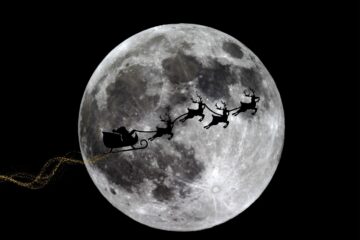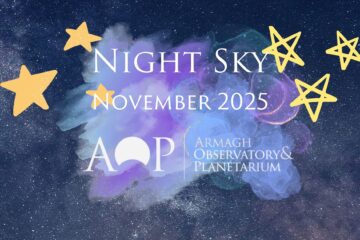Article written by: Yanina Metodiva
It’s the beginning of a new month, filled with new exciting events in the night sky. Here is a brief summary of what to expect in the next few weeks.
The Planets in August
In August we will be able to see all the planets in the Solar system.
Mercury
Mercury is currently hiding near the Sun, rising just a few minutes before sunrise. In the second half of August it will be easier to observe, rising earlier and earlier in the morning hours, reaching greatest western elongation on the 26th. This means the planet will be furthest away from the Sun and easiest to spot in the Eastern sky, rising at 4:39am, a whole 1 hour 45 minutes before the Sun.

Mercury as seen on 26th August 2018 at 4:39am. Image Credit: Heather Alexander/Stellarium/Armagh Observatory and Planetarium
The Moon and another eclipse
Technically our Moon is not a planet, but I’d like to include some information about its phases here. In the first days of August the Moon is Waning Gibbous, slowly melting away, rising later and later in the night. It reaches Last Quarter on the 4th and New Moon on the 11th August. On the 11th not only will the Moon be in the New Moon phase, but it will pass directly in front of the Sun, casting a shadow on the Northern parts of our planet and causing a partial Solar eclipse.
This eclipse will be visible in parts of Asia, Europe and North America. In the UK it will be visible from the Northernmost parts of Scotland. This eclipse is the third one in a month, following the partial Solar eclipse on the 13th July, and the longest total lunar eclipse for the century on the 27th July.
More information on the partial solar eclipse on the 11th August HERE. It is interesting to mention that this eclipse will occur exactly 19 years after the total solar eclipse of 1999, visible from most of Europe.
Venus
Venus is visible in the Western sky shortly after sunset. The brightest planet will be setting about an hour after the Sun in the Western sky. Venus and the Moon will be closest together, or ‘in conjunction’, on the 14th August just after sunset.

Venus, Mars and Saturn as seen from the Armagh Observatory and Planetarium. Image Credit: Yanina Metodiva
Mars
Mars has just passed opposition, or its closest point to us, in the end of July. The Red Planet rises shortly after sunset and is visible throughout the whole night. For the next couple of weeks it will still be very close to us and, if you have a small telescope, you might be able to see some detail on the disk like the polar caps and some valleys across the center of its disk. Mars will be in conjuction with the Moon on the 23rd August.
Jupiter
Jupiter is visible after sunset, setting around midnight in the beginning of the month. It will be moving closer to the Sun in the following weeks, setting earlier and earlier in the night. In the end of August, Jupiter will be setting just after 10pm. The biggest planet will be in conjunction with the Moon on the 17th.
Saturn
Saturn will be in the boundary of the constellation Sagittarius for the month of August, very close to the centre of the Milky way. This makes the planet very attractive for astrophotography. It will be visible for the majority of the night, setting around 2:30am in the beginning of the month, and around 00:30 towards the end of August. It will be in conjunction with the Moon on the 21st August.
The Perseid meteor shower – 13th August
Often I hear on the news or read in the paper that the Perseid meteor shower will be the best meteorite shower for this year. So first, I feel the need to explain the difference between a meteor, meteorite and meteoroid.
Most meteors come from small dust particles and fragments left behind from comets (or sometimes asteroids). Asteroids are big rocks and comets are basically large dirty snowballs flying through space. When a comet passes close to the Sun, some of its ice warms up and evaporates, creating a beautiful tail. During this process small dust particles are also blown away from its surface, leaving a small trail behind the comet.
Sometimes, if a comet crosses the orbit of the Earth, parts of its trail occasionally reach our planet. When a small grain of comet dust falls towards the Earth, it burns in the upper layers of our atmosphere. The flash of that burn we call a meteor, and the dust grain is the meteoroid. Every once in a while, a bigger fragment of the comet burns through the atmosphere and some of it reaches the Earth’s surface. The part that reaches the Earth is called a meteorite.
And now back to the Perseids.
The Perseid meteor shower is the most attractive one for the summer. It is caused by debris left behind from comet Swift-Tuttle. During the peak (on the night of the 13th August), we will be able to see about 95 fast white meteors per hour that leave bright trails. Meteor showers always appear to be coming from the same point in the sky, and for the Perseids this point is in the constellation Perseus, hence the name. It will be above the horizon the whole night, so if you go out after dark and look towards the North-West, you will be able to spot a few meteors coming from that part of the sky. The Moon will be a very very thin crescent, just 2 days after New Moon, setting shortly after sunset leaving us with pitch black sky.
I do feel obliged to give you a few tips if you wish to observe and/or photograph the meteors.
First and foremost, bring very warm clothes with you. I know it is the middle of the summer and we have been enjoying some lovely warm weather, but if you do go out to observe a meteor shower, you’re lying still for hours at a time, your body cools down and eventually you get numb. I observe this shower every year, and every year I go out with at least 3 layers of warm winter clothes, a sleeping bag and a mat for under the sleeping bag. A flask with hot tea/coffee helps a lot.

Perseids Meteor shower. In the background we can see very distinctly The Plough, also known as The Big Dipper. Image Credit: Yanina Metodiva
When observing a meteor shower, I always have a torch with me, that has a red light. If you only have a white light one, stick some tape or paper to the front of it to dim its light. Red light doesn’t affect your night vision, allowing you to keep your eyes adjusted to the dark.
If you wish to photograph some meteors, I would recommend you to mount your camera on a tripod and leave it staring at the same patch of sky all night. I normally use exposures of about 20-30 seconds, mid-to-high ISO, and I have a small remote that allows me to program my camera to take, say, 300 photos at such-and-such exposure time without me pressing the button every time. I always have a spare battery, and it is useful to know that your camera will inevitably became wet. The dew settles in around midnight or so, leaving all of your equipment wet, so keep everything you don’t use at the moment, in the camera bag (or any other waterproof bag). I also have a small tube made of cardboard that I put on my lens, it looks stupid, but it protects it from most of the dew. Check your camera once every hour or so to make sure it’s still shooting images, it’s dry, and the battery is not dead. And good luck!
A few brighter comets
As we approach the autumn months, there will be several comets visible with binoculars or a small telescope.
21P/Giacobini-Zinner
This comet was discovered in December 1900, and it has a period of about 6.6 years. 21P is a small comet, about 2km in diameter, and it will be closest to the Sun on the 10th September this year. It is still faint to be observed with binoculars, but in the coming weeks it will brighten up significantly.
For current position and brightness, check the following website: HERE.
38P/Stephan-Oterma
This comet was discovered in 1867. It has an orbital period of about 38 years, and it will reach perihelion on the 26th August 2018. It will be bright enough for binoculars or a small telescope. The comet will be closest to our planet in January 2019.
More information click HERE
46P/Wirtanen
Comet 46P/Wirtanen was discovered in 1948, and is a short-period comet orbiting out Sun once every 5.4 years. 46P is now approaching perihelion, which will happen in early December. It is expected the comet to be bright enough to be seen with the naked eye, potentially reaching 3rd magnitude brightness. On the 16th December this year, the comet will make its closest approach to the Earth, of only 0.078 Astronomical Units (the distance between the Earth and the Sun), or 11.7 million km.
More information on its orbit and close approach can be found HERE.
A month without the International Space station.
For the month of August, the International space station will only have three visible passes above Northern Ireland. These are on the 1st, 2nd and 4th of August. Then the ISS will not appear again until the beginning of September. More information on when will it be visible above you on heavens-above.com (don’t forget to put in your coordinates there).





0 Comments